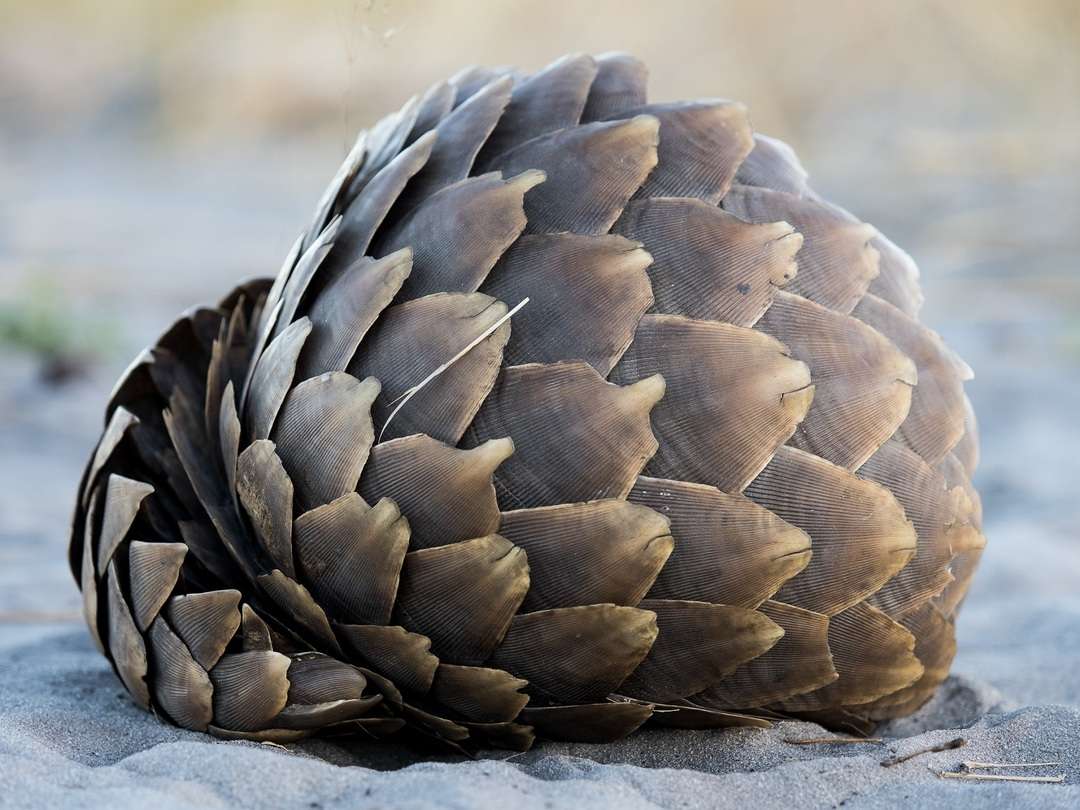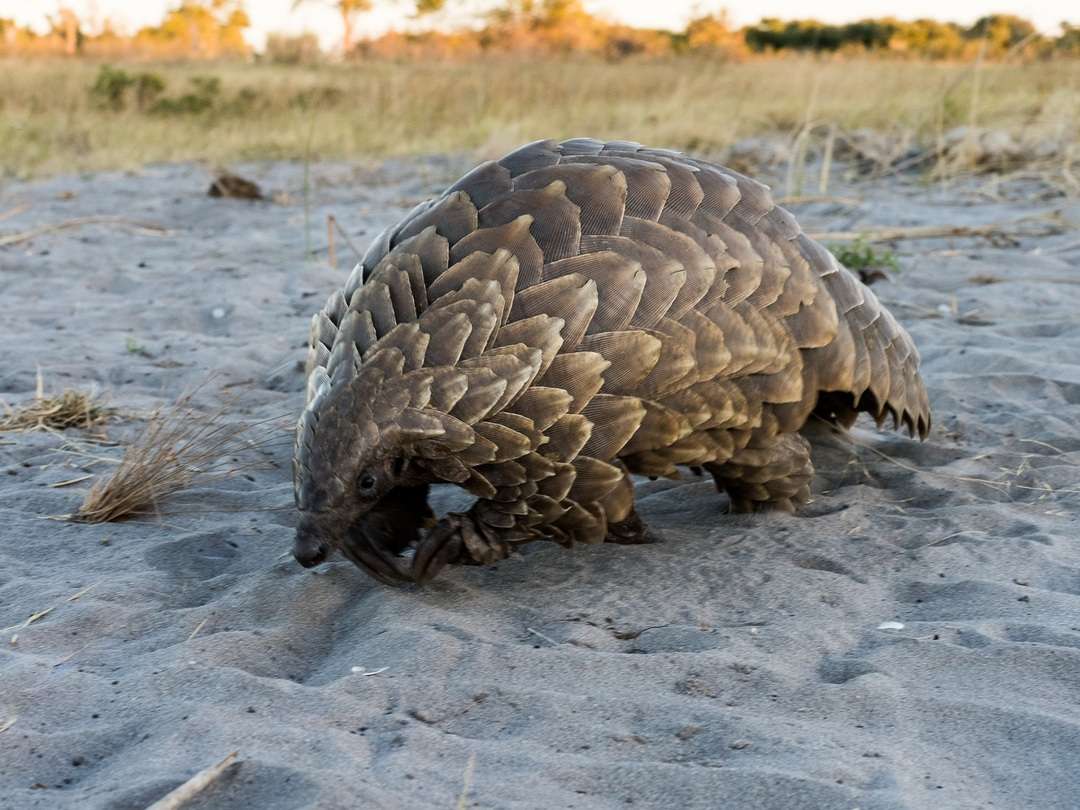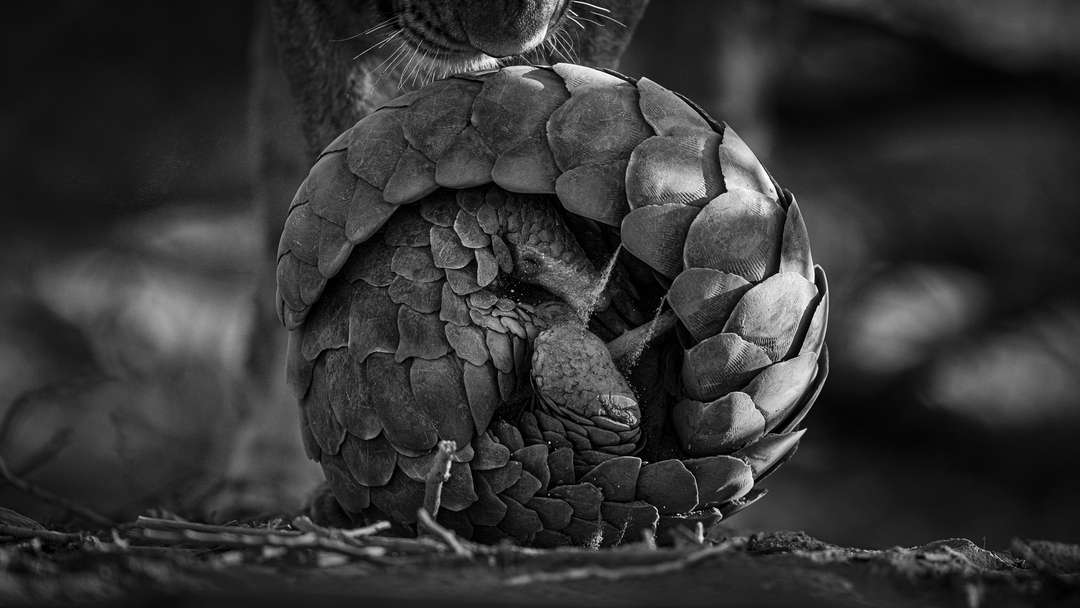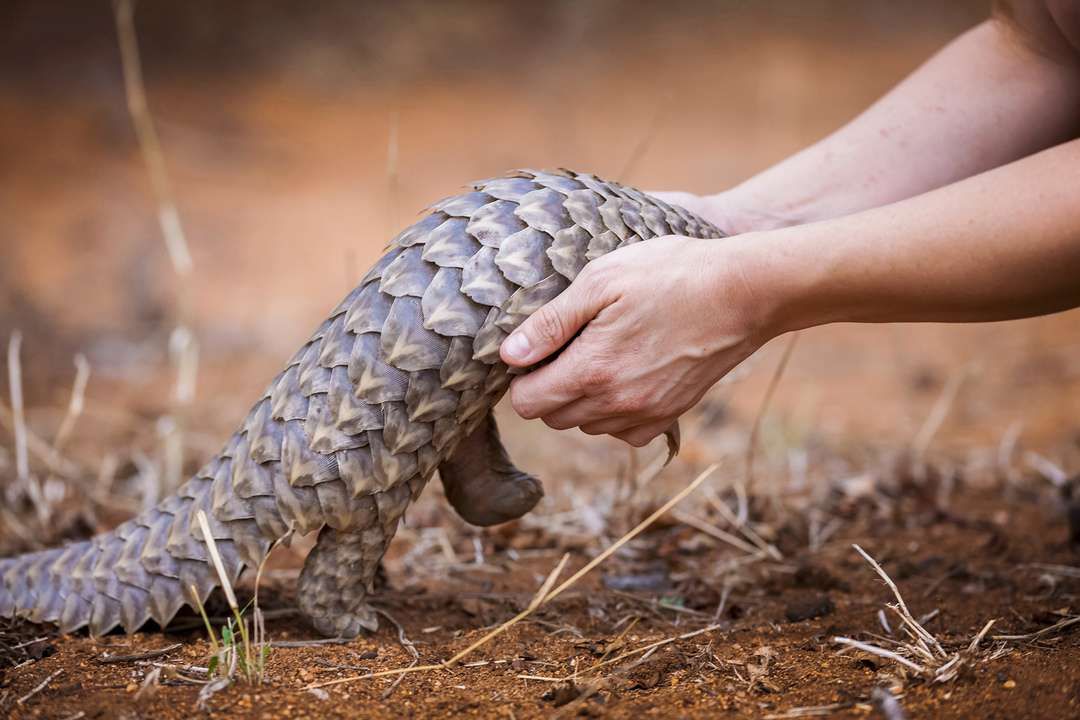World Pangolin Day

A day dedicated to celebrating and raising awareness about this unique African mammal – which is not just the world’s only truly scaly mammal but also, unfortunately, its most trafficked.
In honour of pangolins, we tell you a bit more about this incredible creature, the plight they face in Africa and the world today, and the work that is being done to save them from extinction.
What is a Pangolin?
The pangolin is a shy, elusive and secretive scaly mammal which is endemic to Asia and Africa. All eight species of pangolin comprise their own Order: Pholidota. The word ‘pangolin’ comes from the Malay word ‘penggulung’, which means ‘one that rolls up’. This refers to the way a pangolin animal will curl itself into a tight ball when threatened, which is impenetrable to predators. They have small heads but long snouts and even longer tongues for slurping up ants from inside ant nests, leading some people to also call them scaly anteaters.
Why are Pangolins so Unique?
Pangolins are unique, because although their closest relatives are carnivores, they are the only mammals whose bodies are covered in scales rather than fur. Most of a pangolin’s head and tail are covered in horny, sharp and overlapping scales – the exceptions are the sides of the face, the inner parts of the legs, the throat, and the belly. The pangolin’s scales make up 20 percent of its total body weight and are composed of keratin, the same material that makes up human fingernails. Like hair, the scales carry on growing throughout the animal’s life, though they are ground down when it digs and burrows in search of food. Pangolins are also unique as they have more vertebrae than any other animal.

Africa, Home to Four Species of Pangolin
In Africa, pangolins are dispersed throughout southern, Central, East and West Africa, with four species endemic here. These include the giant ground pangolin Smutsia gigantea, Temminck’s ground pangolin Smutsia temminckii, the black-bellied pangolin Phataginus tetradactyla and the white-bellied pangolin Phataginus tricuspis. Three of these species of pangolin are primarily nocturnal, and one is diurnal.
Temminck’s Ground Pangolin – Endemic to Southern Africa
The Temminck’s ground pangolin, which can grow to 1.2 m long and 15 kg in weight, is the most widespread of all the African pangolin species and occurs in Southern Africa. They are predominantly nocturnal, although in the Kalahari and other cool regions many individuals become more diurnal during winter. Juveniles have a greater tendency to be active during the day throughout their range.
This is a solitary, terrestrial species that inhabits mainly savannah and woodland in low-lying regions with moderate to dense scrub, where average annual rainfall is between 250 mm and 1,400 mm. They also occur in floodplain grassland, rocky slopes and sandveld up to 1,700 m above sea level, but do not inhabit forest or true desert. Sightings have also been recorded on well-managed livestock farms, where it is afforded protection from human predation, but they are absent from croplands and human settlements.
They do not dig their own burrows, but rather make use of old burrows that were dug by other species such as aardvark, porcupine, warthog and springhare.
The most important habitat requirements for this species are believed to be a sufficient population of the various ant and termite prey species and the availability of dens or above-ground debris in which to shelter. Ambient temperatures and annual temperature fluctuations are also crucial, as these directly affect the prey species, while pangolins also have poor thermoregulatory capabilities and appear to rely on environmental conditions for thermoregulation.
Searching for Pangolins on an African Safari
Pangolins are very often at the top every safari enthusiast’s wish list. As well as being one of the most sought-after species to catch a glimpse of, this incredibly rare animal is also one of Africa’s most difficult to find. Some of the best areas for ground pangolin sightings in southern Africa are the Kalahari and Karoo regions in South Africa, Mana Pools and Hwange National Parks in Zimbabwe as well as the Central Kalahari, Linyanti Wildlife Reserve and Okavango Delta in Botswana.
A Toothless Ant-Eating Frenzy
Pangolins are entirely insectivorous as they only feed on ants and termites. The proportion of ants and termites consumed varies seasonally and geographically, but typically 90 – 95% of their diet consists of ants, while the remaining 5 – 10% are termites. A single pangolin literally consumes millions, if not billions, of ants and termites, and their larvae, each year. They are very selective about the species of ants and termites, and do not simply eat the most abundant species.
Because they are toothless, they use their tongues to collect their prey. Large salivary glands coat the long tongue with a gummy mucous, to which ants and termites stick. The tongue is as long as the head and body combined and is retracted into a special sheath, which extends along the abdominal wall to the pelvic region and curls upwards and forwards before ending in a blind sac against the diaphragm. Pangolins also rely on their gizzard-like stomachs to grind food, which is helped along by the small stones and sand they consume during a feeding frenzy.

What Do You Call a Baby Pangolin?
Pangolins are solitary, with males and females only coming together briefly to breed. It is believed that males and females locate each other while out foraging, through a scent 'trail' that is left by the female. If a female is receptive, the male will approach her and after some courtship will mount her from the side. They will eventually retire to the female's den and may remain together in the den for up to three days, presumably mating at frequent intervals. Pangolins give birth to single pup (rarely twins) after a gestation period of 105 – 140 days. It is suspected that females may only give birth every second year.
The pups are born with fully formed but have soft scales, which harden over the first few days. The mother leaves the baby in a burrow (terrestrial species) or hollow tree or log (arboreal species), periodically returning to nurse it. When about one month old, the baby accompanies the mother while she forages. The pup hitches a ride on the base of the mother’s tail, hooking its claws under the mother’s scales. As the pup grows it becomes more adventurous, alternating riding on the mother’s back with foraging nearby. The offspring typically remains with the mother for 3 – 6 months, but will remain in their natal home range until about one year old, after which they will start dispersing.
Pangolins are the Most Trafficked Mammal in the World
All eight species of pangolin are threatened with extinction and are listed on the IUCN Red List as either Vulnerable, Endangered or Critically Endangered.
Since 2017, all eight species of pangolins are prohibited from international trade under the Convention on International Trade in Endangered Species of Wild Fauna and Flora (CITES). Pangolins were moved to CITES Appendix I, which also provides for better local protection in key countries such as Vietnam and China.
However, in just ten years, more than 1 million pangolins have been illegally traded, which makes them the most trafficked mammals in the world. The illegal pangolin trade is of global conservation concern and trafficking occurs well beyond African and Asian pangolin range states.
Vast quantities of them are now also being smuggled from Africa to Asia.
A report published by TRAFFIC, a wildlife trade monitoring network, found that at least 120 tonnes of whole pangolins, parts and scales were confiscated by law enforcement between 2010 and 2015, involving a total of 1,270 seizure incidents in 67 countries or territories. In these 6 years, 159 unique international trade routes were identified, with 27 new unique routes emerging every year. Between 2016 and 2019 these numbers increased to 228 tonnes of pangolin body parts. Unfortunately, until demand for pangolins and their parts is curtailed, and as long as there is a profit to be made, traffickers will continue to find ways to meet that demand.
Other Threats to a Pangolin’s Survival
According to the African Pangolin Working Group, large predators, starvation, fires and possibly disease pose a threat to wild pangolins, but the vast majority of threats facing pangolins today are of a human origin. Besides domestic and international trade, the following threats also need to be considered:

Hunting
In Central and West Africa pangolins are predominantly used as a source of food. Many villagers in these areas view pangolins as just another variety of protein or bushmeat, and they are hunted as such. Some cultures hold pangolin meat in high esteem and serve pangolin meat to dignitaries or on special occasions. After being captured and killed, the pangolins are roasted over a fire or boiled to remove the scales, which are discarded, and the meat preserved.
Habitat loss
Habitat loss is a significant threat to pangolins. Across Africa. With the burgeoning human population, there is an ever-increasing number of people relying on an ever-dwindling supply of natural resources. In addition to this, improved logistics and infrastructure are also contributing to the demise of this endangered species. Areas that were previously inaccessible become easily accessible, with a transport network nearby to transport any harvested resources, with the result that this area becomes over-utilised. Mines, agriculture and settlements result in significant habitat loss, especially in West and Central Africa. The best way to conserve these habitats, and thus pangolins and other threatened species, is by supporting local ecotourism ventures as those initiated by Wilderness in various African countries.
Electrified fences
Electrified fences pose a significant threat to pangolins, especially in southern Africa where these structures are ever-present. It is estimated that between 440 and 1,190 pangolins are inadvertently killed on electrified fences in southern Africa every year. These electrocutions are accidental and relate to the pangolin’s behaviour of walking on its hind legs with the front legs and tail held off the ground, acting as a counterbalance. The belly is not protected by scales and when the pangolin’s belly encounters an electrified wire the shock is perceived as a threat. Pangolins only have one defence when faced with a threat – rolling into a ball, often inadvertently curling around the electrified wire in the process. Each successive shock causes the trapped pangolin to curl tighter around the wire until it succumbs to either electrocution or exposure.
Scaling Up Pangolin Conservation Efforts in Africa
We envision a world where all eight pangolin species are safe from extinction. To get there, we must stop the killing, stop the trafficking, and stop the demand. To conserve pangolins in Africa, various conservation organisations are teaming up to save this species. These include mainly:
The IUCN SSC (Species Survival Commission) Pangolin Specialist Group, a voluntary network of experts from around the world, including field biologists, social scientists, zoologists, veterinarians, ecologists and geneticists, all of whom are actively involved in pangolin research and conservation. Its mission is to work within the framework of the IUCN SSC to secure a future for wild pangolins through advancing knowledge on pangolin status, threats and conservation priorities, and by catalysing action to conserve them.
The African Pangolin Working Group, which is actively involved in conserving this species in Africa through the identifying and mitigation of threats, overseeing the rehabilitation of pangolins in South Africa, educating and liaising with law enforcement, managing the counter-poaching K9 pangolin-detection programme, as well as mapping the past and present distribution of all pangolins occurring on the African continent.
A Pangolin Conservation Success Story
In April 2020, a female pangolin named Ally was retrieved out of the illegal trade in Limpopo, South Africa. Dr Karin Lourens, veterinarian at the Johannesburg Wildlife Veterinary Hospital proceeded to stabilise and examine the pangolin. During an abdominal ultrasound it was discovered that Ally was pregnant.
She was housed at a secure location and began to recover from her trauma. It was important for her to recover quickly but gently, to prevent her from miscarrying her pup. A few weeks later she was transported to a release site in the Limpopo Valley. Telemetry tags were attached to her scales for post-release monitoring, critical to ensuring the animal’s wellbeing in the wild.
Some weeks later, the African Pangolin Working Group’s release team noticed that Ally had used the same burrow for a few weeks and placed camera traps at the burrow to continue to monitor her. In one of these recordings the team saw that Ally had given birth and her pup was in the burrow. This is the first time we have a record of an African pangolin successfully giving birth after being retrieved out of the illegal wildlife trade. Indeed, a wonderful success story for pangolin conservation!

Rescue and Release

Let’s plan your next journey
Ready?
When we say we’re there every step of the way, we mean it, literally. From planning the perfect circuit, to private inter-camp transfers on Wilderness Air, and easing you through Customs. We’re with you on the ground, at your side, 24-7, from start to finish. Ready to take the road less travelled? Contact our Travel Designers to plan an unforgettable journey.